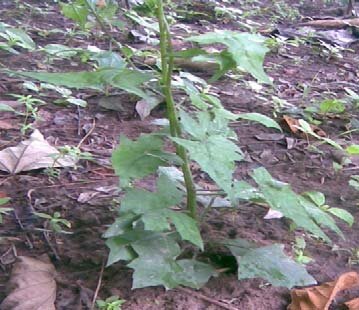Senecio biafrae

|
|
Solanecio biafrae Common Names: English Spinach Scientific
Classification Kingdom: Plantae Phylum: Tracheophyta Class: Magnoliopsida Order: Asterales Family: Asteraceae Genus: Solanecio Species: S. biafrae Synonyms: Senecio biafrae Oliv. & Hiern, Crassocephalum biafrae (Oliv. & Hiern) S.Moore Morphological Description Solanecio biafrae is a perennial, scandent herbaceous plant, growing up to 3–4
m long, often climbing over other vegetation for support. Its key features
include: · Stem: Succulent, glabrous, strongly branched from 50 cm above
ground, twining · Leaves: Alternate, simple, triangular to hastate, 2.2–9 cm long,
1.3–6.2 cm wide, succulent, mucilaginous, with slender petioles (0.8–5.5 cm) · Inflorescence: Terminal, discoid capitula in loose thyrses, with numerous
small yellow flowers · Fruit: Small achenes with a white pappus, aiding wind dispersal The mucilaginous leaves
are a culinary hallmark, often steamed to reduce sliminess (Fern, 2024). Distribution and Habitat Solanecio biafrae is native to tropical West and Central Africa, spanning
Nigeria, Ghana, Togo, Cameroon, and the Democratic Republic of Congo. It
thrives in: · Ecosystems: Primary and secondary forests, cocoa plantations, and shaded
undergrowth · Climate: Humid tropics (rainfall 1,500–2,500 mm annually),
temperatures 20–30°C · Soils: Moist, well-drained, rich in organic matter, often acidic
(pH 5.0–6.5) It is commonly protected
in Nigerian cocoa plots for economic and culinary use (Bello et al., 2018). Ethnopharmacology Solanecio biafrae, commonly known as Sierra Leone bologi or wòròwó among the
Yoruba-speaking people of southwestern Nigeria, is a perennial climbing herb
indigenous to West Africa. Traditionally, it has been utilized for various
medicinal purposes, including enhancing lactation, promoting wound healing,
treating sore eyes, alleviating coughs and heart ailments, relieving rheumatic
pain and allergies, and managing diabetes and female infertility. Phytochemical
analyses have identified compounds such as tannins, saponins, flavonoids,
alkaloids, and terpenoids, contributing to its medicinal properties.
Nutritionally, the leaves are rich in proteins and fibers, supporting their use
in diets aimed at managing obesity and promoting overall health. Furthermore,
studies indicate that the plant exhibits antibacterial and antioxidant
activities, validating some of its traditional uses in treating infections.
These findings underscore the multifaceted medicinal potential of Solanecio
biafrae, aligning with its extensive use in traditional African medicine. · Coughs: In Nigeria, leaf decoctions treat coughs; antimicrobial
activity against Streptococcus pneumoniae (MIC 64 µg/mL) noted (Mongalo et al., 2015). · Heart Troubles: In Ghana, leaves are consumed as a tonic;
antioxidant properties (DPPH scavenging 85% at 50 µg/mL) may support
cardiovascular health (Bello et al., 2018). · Galactagogue: In Togo, leaf extracts promote lactation; traditional use
aligns with nutrient richness (Adebooye, 2006). · Diabetes: In Cameroon, leaf supplementation reduced blood glucose by
53.57% at 300 mg/kg in diabetic rats, enhancing insulin secretion (Erukainure
et al., 2019). · Antioxidant: Leaf extracts inhibited α-amylase (IC₅₀ 110.4 µg/mL),
reducing oxidative stress in rats (Dada et al., 2017). ⚠ Toxicity Profile: While generally safe as a food, some Senecio species contain pyrrolizidine alkaloids,
potentially hepatotoxic at high doses (>1 g/kg daily). Specific data
for S. biafrae is
limited, but no acute toxicity is reported at culinary levels (Burkill, 1985). Additional Uses · Nutritional: Leaves offer 18% protein, 2.8 mg/100g iron, and 1.2 mg/100g
niacin, enhancing dietary diversity (Ogbuagu, 2008). · Economic: Sold in West African markets, contributing to food security
(Bello et al., 2018). · Cultural: Used in Yoruba rituals for initiation and healing (Burkill,
1985). References
External Links More Pictures |
|
| Compounds of Senecio biafrae |
|
| References |